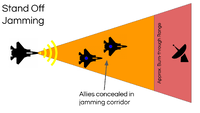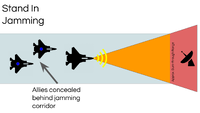Electronic Warfare (Mechanic)
Electronic Warfare, often abbreviated EW, is a gameplay mechanic in VTOL VR.
At its core, electronic warfare centers around disrupting the use of radar, guidance, and communications to gain an advantage in air-to-air or air-to-ground combat. Use of high-tech jammers and decoy missiles can decrease the enemy's ability to effectively track and engage targets, and force them to rely on inaccurate information.
EW Capable Units
Playable
- The F/A-26B and T-55 can equip the AN/ALQ-131 ECM pods for electronic attack.
- The F-45A has a self-defense jammer built directly into its radar.
- The EF-24G can equip more advanced EW tools: the AN/ALQ-245 Electronic Warfare pods and ADM-160J air-launched decoys.
AI Units
- The ASF-30 can equip the NJ-50 ECM Jammer, a facsimile of the AN/ALQ-131 with similar capabilities.
- The GECM Truck, a mobile multi-band jammer truck, is available to both teams.
- The Decoy Launcher, a stationary platform for launching ADM-160J-SL decoys, is available to both teams.
Jamming Modes
NOISE

Available to: AN/ALQ-131, AN/ALQ-245, ADM-160J, F-45A Internal Jammer.
The NOISE mode is the simplest form of jamming that works by overwhelming the target radar with a large amount of noise, making it very difficult to find any actual radar returns within the cone of effect. This includes the returns of other allies through corridor jamming.
Enemy aircraft will see this effect as green squares on their radar display. While receiving noise jamming, real radar returns will be obscured within the noise until the target is inside the burn-through range. Increasing power creates more noise and lowers the radar's effective burn-through range.
Noise jamming is useful for more than just enemy aircraft and SAM sites. HI band jamming on a Missile Warning Radar can leave a base's defense network vulnerable to missiles and bombs, and disrupt the targeting system of anti-air artillery emplacements. LOW band jamming works on the powerful radars aboard AWACS and other early warning installations and can knock out GPS reception on planes or munitions that require it for guidance.
The Fire Control Radar cannot be used while transmitting noise.
| NOISE Band | Effective against... |
|---|---|
| LOW |
|
| MID |
|
| HI |
|
While noise jamming may break a Track While Scan lock, it is not effective against a Single Target Track (STT) or an internal missile radar. Against targets who have acquired a Single Target Track, the only effective jamming mode is DRFM.
Noise Jamming Missiles
Noise jamming is generally ineffective against missiles in flight, due to the resistance that Single Target Tracks have against noise jamming. This means that noise jamming will not work against missiles that have already pitbulled on a target, as the missile has already established a hard-lock on it. Furthermore, targeting the missile with noise jamming is also ineffective during the mid-course phase, as the missile is actively receiving guidance information from the launching aircraft.
Therefore, the only time noise jamming works against missiles is while the search radar is active, but has not found a target, which happens when the missile is fired in MADDOG mode or when the guiding aircraft stops sending guidance information to the missile. During this time, the missile's search radar operates in the mid-band frequency, and it's ability to search for, and lock targets can be degraded with mid-band noise. However, the AIM-120C and it's OPFOR counterpart, the ASMRM-7 will switch from search mode to Home-on-jam modes in response to mid-band noise, which renders noise jamming mostly ineffective against these missiles.
Corridor Jamming
Allies can position themselves along the jammer's azimuth (direction of transmission) to effectively hide from radar, in either an offensive or defensive manner.
Stand Off Jamming is done from behind allied aircraft, where they are hidden within the cone of effect, while Stand In Jamming is in front of allies and are concealed behind the cone of effect.
DRFM

Available to: AN/ALQ-245.
The DRFM mode works by receiving incoming radar pulses, modifying them, and retransmitting radar returns back to the enemy. By default, DRFM will automatically select the correct band to transmit on according to your target. Unlike NOISE, this mode cannot be used to directly support other allies.
DRFM does not prevent use of the Fire Control Radar.
Search Mode
To radars in search mode: this effect will appear as a cluster of false radar contacts around the aircraft, making target acquisition more difficult and missing the real target more likely. Increasing transmitting power or painting a target with multiple DRFM jammers creates more false radar contacts. Be aware that your own aircraft's true radar returns are included among them.
STT Mode
To radars in Single Target Track mode: the DRFM transmitter will attempt to break the lock using RGPO. By exploiting where the enemy radar expects your aircraft to be (the range gate), DRFM will transmit a stronger false return within the range gate and direct it away from you, eventually breaking the STT lock. Even if a missile regains a lock, it must make steep turns to maintain its lead ahead of you and waste its available energy. Increasing transmitter power on a target with an STT lock will increase effectiveness of the RGPO. Reducing your own aircraft's RCS, by changing your aspect angle and dropping your weapons, as well as notching will also increase the effectiveness of RGPO.
SAS
Available to: AN/ALQ-245, ADM-160J.
The SAS mode works similarly to DRFM; the SAS jammer will receive incoming radar pulses and send them back as incorrect aircraft returns. The end result is that an aircraft (or decoy) can appear on radar as a different vehicle. It is possible for the EF-24G or MALD to disguise itself as any other allied aircraft.
Power management is crucial to appear convincing during SAS spoofing, as radar detection range is directly tied to power allocated to the transmitter. Reduce power to appear at a consistent range for the profile of aircraft being spoofed; an F-45A visible on radar at 30 miles may not deceive the enemy for long.
SAS mode does not prevent usage of the Fire Control Radar.
Burn-Through Effect
A radar's burn-through range is simulated in VTOL VR. Radars must compete with a jammer between the signals it receives, meaning a jammer can overpower it with noise or false returns that are much stronger than the radar's own returns. However, within a certain range the opposite occurs: the radar's real returns start getting through and the jamming effect is nullified.
The two key factors in this range are jammer power output vs. radar power output. Radar cross section and distance play a small part but is negligible under most circumstances.
Keep in mind not all jammers, and especially not all radars, are created equal. An immensely powerful radar aboard an E-4 Overlord or MAD-4 Radar will have a large difference in burn-through range compared to ones on fighters, and weaker short-range radars will have a minuscule risk of burn-through.



